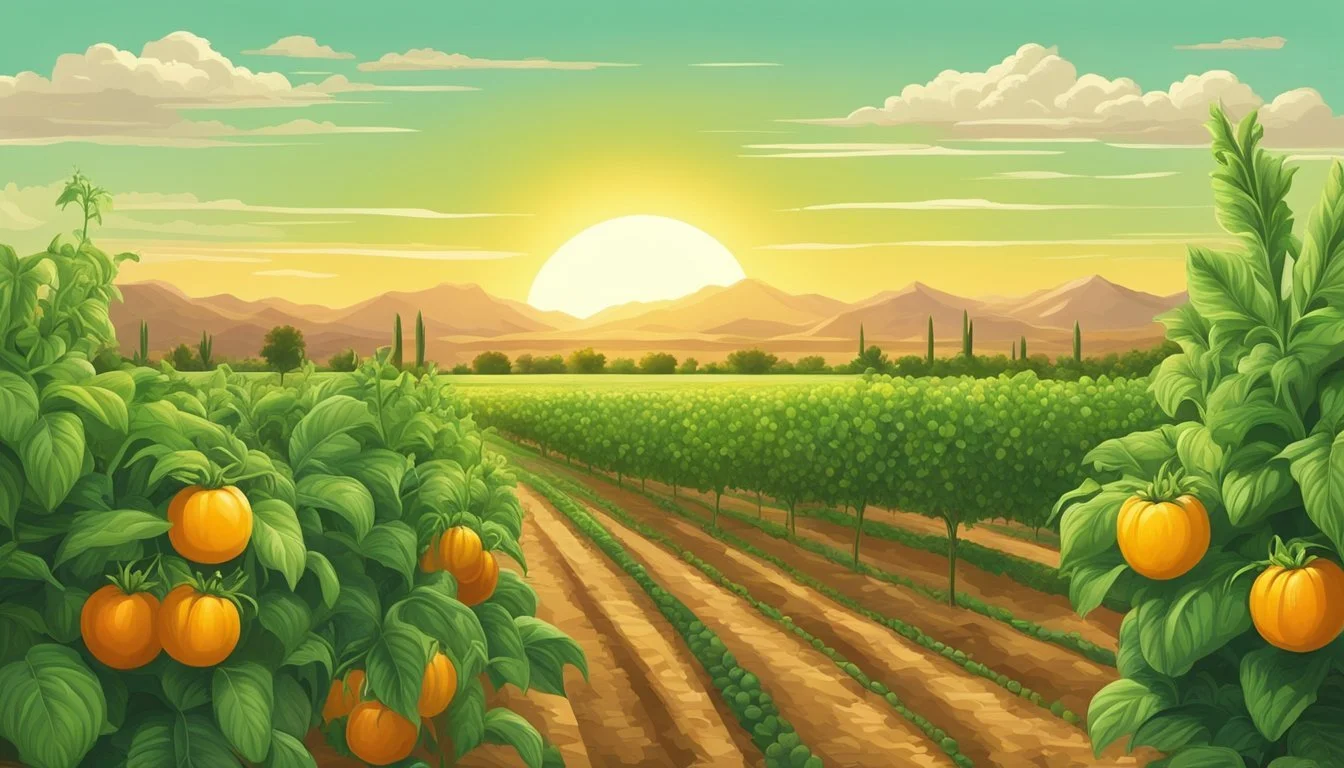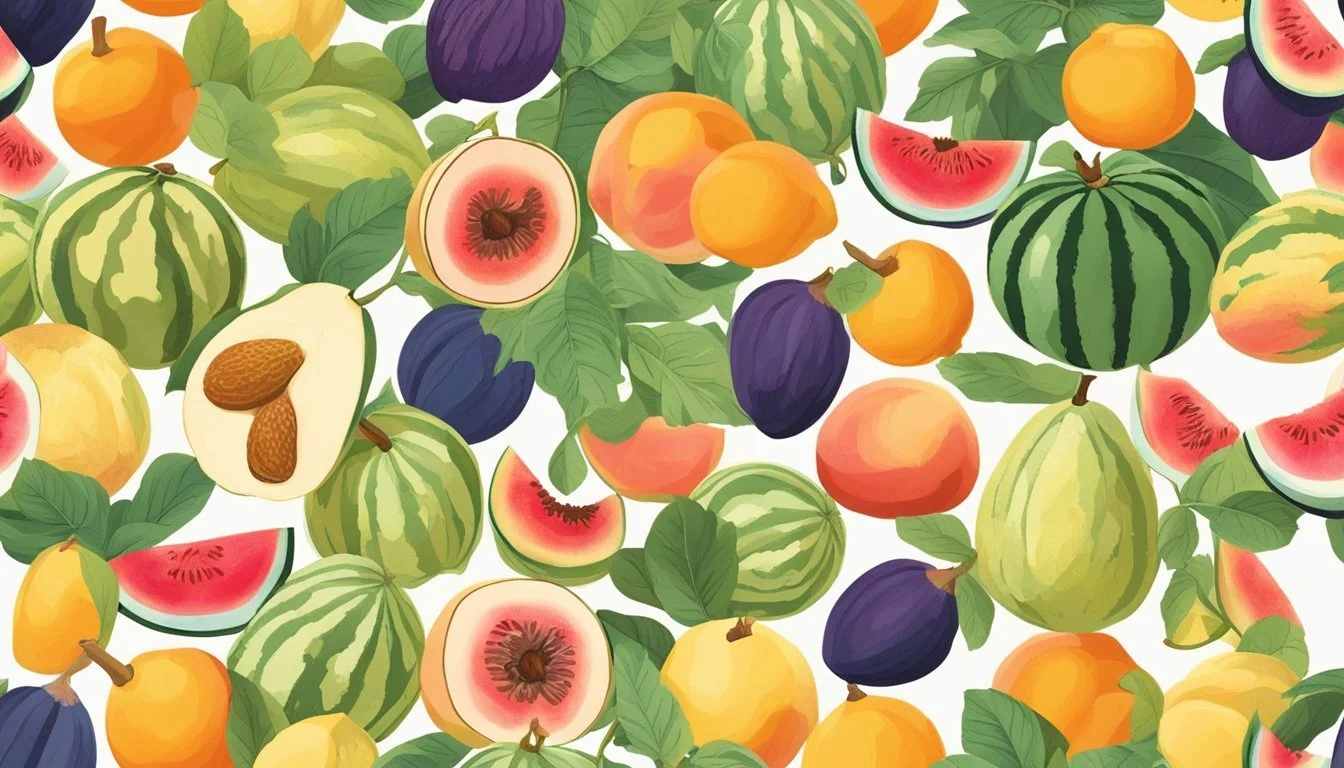Arizona Seasonal Fruit & Veg Guide
Your Year-Round Companion
Arizona's diverse climate, ranging from low desert to high plateau, offers a bounty of seasonal fruits (What wine goes well with fruits?) and vegetables that local farmers bring directly to consumers' tables. Embracing the farm-to-table movement, Arizona supports a vibrant agricultural community, which ensures fresh, flavorful produce is available throughout the year. Consumers who shop within the state's seasonal rhythms not only get the freshest fruits and vegetables, but they also contribute to sustainable farming practices and the local economy.
As the seasons change, so does the available produce in Arizona. Winter's cooler temperatures bring forth a harvest of citrus fruits like Clementines, leafy greens, and cruciferous vegetables such as broccoli and Brussels sprouts. Transitioning into spring, the selection broadens with an array of colorful produce. By the time summer heats up, farmers are picking the sweetest peaches, a highlight of the state's fruit calendar. This cycle offers a palette for a diverse and healthy diet year-round, aligning with the state's farming capabilities and natural growing conditions.
Understanding the peaks of Arizona's harvest calendar not only enhances the dining experience but also supports local farmers who strive for high-quality produce with minimal transportation time. As such, the people of Arizona have access to some of the freshest and most nutritious ingredients for their farm-to-table meals. With this commitment to local, seasonal eating, consumers play an essential role in a sustainable food system that benefits the entire state.
What’s in Season in Arizona Right Now?
Understanding Arizona's Growing Seasons
Arizona's diverse climate allows for a multitude of fruits and vegetables to thrive throughout the year. Each season brings a fresh wave of produce to the local farmers' markets, ensuring that residents and chefs alike can enjoy farm-to-table freshness.
Early Spring Varieties
In April, greens such as lettuce and spinach, along with aromatic herbs and sweet peas, are widely available. They are some of the first to appear in farmers markets, heralding the start of the growing season.
Summer Harvest
From May through July, the summer heat ushers in vibrant harvests of corn, cucumbers, melons, and peaches. Tomatoes, a summer staple, ripen under the long daylight hours, ready for a multitude of dishes.
Fall Flavors
When fall arrives in October and November, Arizona sees an increase in apples, carrots, pumpkins, and various types of squash. These fall flavors are celebrated in community dishes and seasonal festivities.
Winter Picks
December through January marks the presence of broccoli, cabbage, and a bounty of citrus fruits like lemons, oranges, and dates. Winter is also prime time for harvesting in Arizona, with cooler weather crops taking center stage.
Year-Round Staples
Greens and arugula (how long does arugula last?), as well as beets and chiles, can often be found throughout the year. Their resilience makes them year-round staples at local markets and in regional dishes.
Regional Considerations and Cool Season Crops
In cooler areas of the state, such as the higher elevations around Flagstaff, cool-season crops thrive. Here, planting strategies adjust to the shorter growing seasons, emphasizing crops like sprouts and greens.
Timing for Planting and Harvesting
The timing for planting and harvesting in Arizona varies by region and climate. However, many cities like Phoenix enjoy a long growing season that can accommodate multiple plantings and a continuous harvest of certain crops.
Climate Impact on Harvest Varieties
Arizona's climate significantly affects what and when produce can be grown, with warmer southern regions extending the availability of certain fruits and vegetables.
Sectional Planting and Harvesting Strategies
Community engagement and knowledge sharing are vital for maximizing the efficiency of sectional planting and harvesting strategies. Local organizations often provide resources to help gardeners and farmers plan for successful in-season production.
By understanding the growing seasons and the regional climate variations across Arizona, locals and visitors alike can revel in the state's rich produce offerings.
Farm to Table: Community and Markets
Emphasizing fresh and locally sourced ingredients, Arizona's farm-to-table movement is deeply tied to its community markets and agricultural programs. Through seasonal offerings and specialized produce, the state fosters a unique connection between local farmers and consumers.
Local Farmers Markets
Farmers markets in Arizona are vibrant community hubs where shoppers can find a wide variety of fresh produce. They are integral in connecting local growers directly with consumers, ensuring that the fruits and vegetables are at their peak freshness. The markets often include citrus fruits, a staple of Arizona agriculture, alongside other fresh offerings.
Farmers Market Guide by Season
Arizona's produce calendar influences the assortment available at farmers markets throughout the year. In the cooler months, markets are abundant with winter vegetables, whereas the summer brings a surge of stone fruits like peaches, as well as melons and tomatoes. A seasonal guide helps shoppers know what to look for:
Winter (November - February): Citrus, leafy greens
Spring (March - May): Strawberries, carrots
Summer (June - August): Peaches, melons, tomatoes
Fall (September - October): Pumpkins, squash
Community-Supported Agriculture (CSA)
Community-Supported Agriculture programs in Arizona allow consumers to purchase a share of a local farmer's harvest. These subscribers receive regular deliveries or pick-ups throughout the season, getting a variety of what's currently being harvested. CSA programs foster community engagement and support for local agriculture, ensuring a market for farmers and fresh produce for the community.
Arizona Specialities and Exclusives
Arizona is known for its unique climate that supports a diverse range of produce not found in many other regions. Exclusives like the heritage dates from the Phoenix area and heirloom tomatoes are sought after. Many of these speciality crops can be found at both farmers markets and through CSAs, celebrating Arizona's rich agricultural variety.
Seasonal Fruit Guide
Arizona offers an abundant variety of fruits across different seasons due to its unique climate, which allows for year-round growing. This guide provides insight into when you can expect to find fresh, locally-grown fruits.
Citrus and Stone Fruits
Citrus: Arizona's warm climate is especially conducive to growing a variety of citrus fruits. The prime months for citrus are typically from December through April.
Grapefruit and oranges are among the most popular citrus fruits and can be found in peak condition during these months.
Stone fruits such as peaches start to become available in May and can be enjoyed throughout the summer months.
Arizona's Berries
Berry season in Arizona brings a burst of sweetness with a variety of berries hitting their peak at different times.
Strawberries usually come first in the spring, followed by blackberries, blueberries, and raspberries during the warmer early summer months.
Melons and Exotic Varieties
Arizona's summer heat supports the growth of an assortment of melon types, with the harvest period extending through the warmest months.
Various melons, including cantaloupe (how long does cantaloupe last?) and honeydew, are typically harvested from late spring into early fall.
Additionally, more exotic fruits such as figs have their season starting mid-summer and can extend into early autumn.
Each fruit's availability can vary year to year based on specific regional weather patterns, but this guide offers a general timeline for when consumers can expect to find these fruits fresh in Arizona.
Seasonal Vegetable Guide
In Arizona, the availability of fresh vegetables varies with the seasons, offering a plethora of options for farm-to-table dining through the year. This guide highlights the prime time to enjoy a variety of vegetables at their peak freshness.
Leafy Greens and Salads
Lettuce: Usually available in the cooler months, from October through March, with varieties such as romaine and butter lettuce.
Spinach: Thrives in cooler weather, best from October through April.
Arugula: Peaks from late fall to early spring.
Root Vegetables and Tubers
Carrots: They are hardy and can be found from October through May.
Sweet Potatoes: Enjoyed in the cooler seasons, they are typically harvested in the late summer and fall but are often available through the winter.
Turnips: Best enjoyed from October through March, when they're at their sweetest.
Summer Squash and Gourds
Zucchini: A summer favorite, available from May through July.
Zucchini Blossoms: Delicate and flavorful, these are best harvested in the summer months, typically alongside zucchini.
Pumpkins: A hallmark of fall, pumpkins are usually harvested in September and October.
Cruciferous and Allium Vegetables
Broccoli: Grows best during the cooler parts of the year, from October through March.
Cabbage: Available from January through April, this vegetable is versatile in many dishes.
Green Onion/Scallions: These mild-flavored alliums can be found from fall through spring.
Leeks: They have a longer growing season and can be found from fall to late spring.






